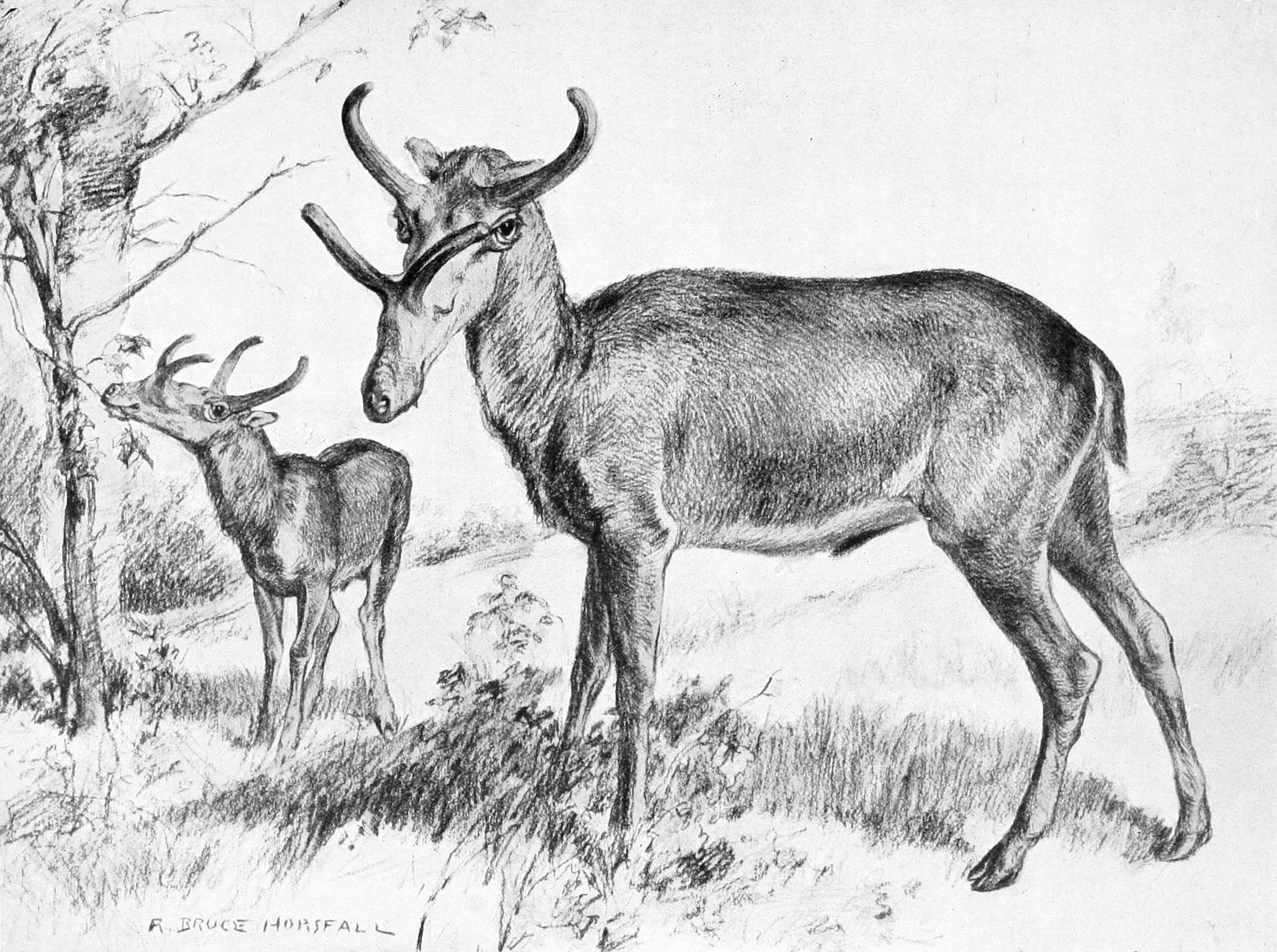Syndyoceras on:
[Wikipedia]
[Google]
[Amazon]
''Syndyoceras'' is a small

 ''Syndyoceras'' was named by Barbour (1905). Its type is ''Syndyoceras cooki''. It was assigned to Protoceratidae by Barbour (1905) and Carroll (1988); and to
''Syndyoceras'' was named by Barbour (1905). Its type is ''Syndyoceras cooki''. It was assigned to Protoceratidae by Barbour (1905) and Carroll (1988); and to
extinct
Extinction is the termination of a kind of organism or of a group of kinds (taxon), usually a species. The moment of extinction is generally considered to be the death of the last individual of the species, although the capacity to breed and ...
genus
Genus ( plural genera ) is a taxonomic rank used in the biological classification of living and fossil organisms as well as viruses. In the hierarchy of biological classification, genus comes above species and below family. In binomial nom ...
of Artiodactyla
The even-toed ungulates (Artiodactyla , ) are ungulates—hoofed animals—which bear weight equally on two (an even number) of their five toes: the third and fourth. The other three toes are either present, absent, vestigial, or pointing poster ...
, of the family Protoceratidae, endemic
Endemism is the state of a species being found in a single defined geographic location, such as an island, state, nation, country or other defined zone; organisms that are indigenous to a place are not endemic to it if they are also found else ...
to central North America
North America is a continent in the Northern Hemisphere and almost entirely within the Western Hemisphere. It is bordered to the north by the Arctic Ocean, to the east by the Atlantic Ocean, to the southeast by South America and th ...
from the Miocene
The Miocene ( ) is the first geological epoch of the Neogene Period and extends from about (Ma). The Miocene was named by Scottish geologist Charles Lyell; the name comes from the Greek words (', "less") and (', "new") and means "less recen ...
epoch (24.8—20.6 Ma), existing for approximately .
Taxonomy

 ''Syndyoceras'' was named by Barbour (1905). Its type is ''Syndyoceras cooki''. It was assigned to Protoceratidae by Barbour (1905) and Carroll (1988); and to
''Syndyoceras'' was named by Barbour (1905). Its type is ''Syndyoceras cooki''. It was assigned to Protoceratidae by Barbour (1905) and Carroll (1988); and to Kyptoceratini
Kyptoceratini is an extinct tribe of the subfamily Synthetoceratinae, deer-like mammals within the family Protoceratidae belonging to the order Artiodactyla, endemic to North America during the Miocene through Pliocene, living 23.03—3.6 M ...
by Webb (1981), Prothero (1998), Webb ''et al.'' (2003) and Prothero and Ludtke (2007).
Morphology
Theskull
The skull is a bone protective cavity for the brain. The skull is composed of four types of bone i.e., cranial bones, facial bones, ear ossicles and hyoid bone. However two parts are more prominent: the cranium and the mandible. In humans, th ...
decoration of ''Syndyoceras'' looked quite unlike those of a deer. It had two pairs of horns. The first was a V-shaped pair on the snout, fused at the base. The second pair was placed between the eyes and the ears and was curved inwards, the horns facing towards each other in a semicircular shape. Like giraffe
The giraffe is a large African hoofed mammal belonging to the genus ''Giraffa''. It is the tallest living terrestrial animal and the largest ruminant on Earth. Traditionally, giraffes were thought to be one species, '' Giraffa camelopardal ...
ossicones, these protrusions were covered with skin
Skin is the layer of usually soft, flexible outer tissue covering the body of a vertebrate animal, with three main functions: protection, regulation, and sensation.
Other animal coverings, such as the arthropod exoskeleton, have different ...
. They were probably used for display and fighting.
In addition to the horns, ''Syndyoceras'' also possessed tusk-like canine teeth, that it may have used to root through soil and undergrowth for food, in a similar manner to a modern musk deer
Musk deer can refer to any one, or all seven, of the species that make up ''Moschus'', the only extant genus of the family Moschidae. Despite being commonly called deer, they are not true deer belonging to the family Cervidae, but rather their f ...
. The shape of the skull also suggests that it may have had an inflated muzzle, like that of a modern saiga
The saiga antelope (, ''Saiga tatarica''), or saiga, is a critically endangered antelope which during antiquity inhabited a vast area of the Eurasian steppe spanning the foothills of the Carpathian Mountains in the northwest and Caucasus in t ...
.
The , creature closely resembled a deer
Deer or true deer are hoofed ruminant mammals forming the family Cervidae. The two main groups of deer are the Cervinae, including the muntjac, the elk (wapiti), the red deer, and the fallow deer; and the Capreolinae, including the re ...
, having two hooved toes and reaching a weight over 60 kg.http://www.questmachine.org/article/Le_Syndyoceras Like early horse
The horse (''Equus ferus caballus'') is a domesticated, one-toed, hoofed mammal. It belongs to the taxonomic family Equidae and is one of two extant subspecies of ''Equus ferus''. The horse has evolved over the past 45 to 55 million yea ...
s, such as ''Merychippus
''Merychippus'' is an extinct proto-horse of the family Equidae that was endemic to North America during the Miocene, 15.97–5.33 million years ago. It had three toes on each foot and is the first horse known to have grazed.
Discovery and nami ...
'', it had two vestigial
Vestigiality is the retention, during the process of evolution, of genetically determined structures or attributes that have lost some or all of the ancestral function in a given species. Assessment of the vestigiality must generally rely on co ...
outer toes on each foot, which did not touch the ground.
References
Protoceratids Miocene even-toed ungulates Aquitanian genus extinctions White River Fauna Miocene mammals of North America Chattian genus first appearances Fossil taxa described in 1905 Prehistoric even-toed ungulate genera {{paleo-eventoedungulate-stub